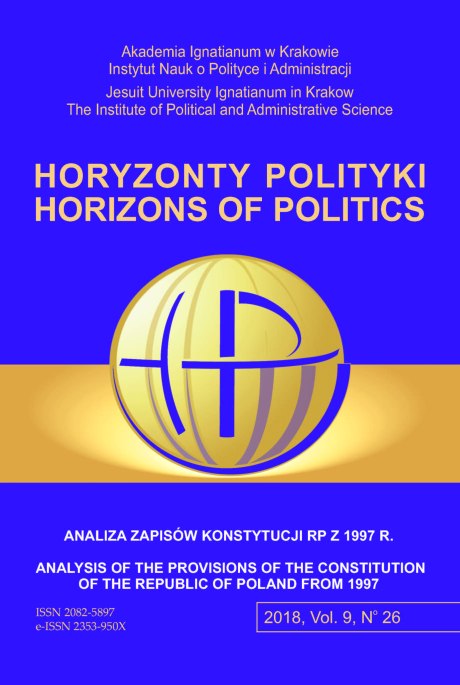Pozycja ustrojowa Prezydenta RP a jego kompetencje w stosunkach zewnętrznych państwa
The Position of the President in 1997 Constitution and his Competencies in Frame of External Relations
Author(s): Marian GrzybowskiSubject(s): Constitutional Law, Governance, International relations/trade, Transformation Period (1990 - 2010)
Published by: Uniwersytet Ignatianum w Krakowie
Keywords: Constitution of April 2nd, 1997; division and balance of powers; foreign policy; Prime Minister; President of Republic of Poland;
Summary/Abstract: Evaluation of the President’s powers in frame of the state’s external relations since the introduction of the constitutional amendments of April 7th,1989 through the Constitutional Act of October 17th,1992 up to the Constitution of April 2nd,1997 ( including their practical implementation). The research problem and methods: In the sphere of foreign relations the constitutional amendment of April 7th, 1989 declared the President (of Poland) to be the main successor of the rights of the liquidated Council of State. The competences were mostly of ceremonial and predominantly formal nature. Since 1990 the direct and universal election of the President has strengthened his political position. Due to over mentioned change and, in addition, because of personal political ambitions of the elected president, the Constitutional Act of October 1992 defined the role of the President as: “general guidance” in the sphere external policies. The Constitution of 1997 defined the role of the President as “highest representative of the state;” but simultaneously it attempted to narrow his competencies to those enumerated in art. 133 of the Constitution. In addition, it made the President (as well as the Prime Minister and the minister responsible for foreign affairs) obliged to co operate when dealing with the foreign policy (“external”) issues. The process of argumentation: When interpreting the constitutional provisions the authors explored predominantly the logical language method. This method was followed up by legal historical interpretation focusing on documentation of the Constitutional Committee of National Assembly as well as by the system analysis methodology in case of analyzed constitutional and political practice. Research results: The “dualistic” (two center) influence mechanism (including the President’ s as well as the Government’s rights and activities) in frame of external relations may favor implementation of “check and balance” mechanism covering differing opinions and initiatives, but on the other hand – it may create conflicts and foster in coherencies within the policies toward the other countries, the European Union and the other international organizations. Conclusions, innovations, and recommendations: The 20-years experience of implementation of analyzed constitutional provisions affecting the “external policy sphere of activities” – both of the President and of the Council of Ministers – tends towards prompt and irrevocable examination of the competences of both two organs in the sphere of external policy just to avoid pointed overlapping areas and to express in more precise way the procedures of mutual cooperation, including the relations with the European Union.
Journal: Horyzonty Polityki
- Issue Year: 9/2018
- Issue No: 26
- Page Range: 129-148
- Page Count: 20
- Language: Polish

